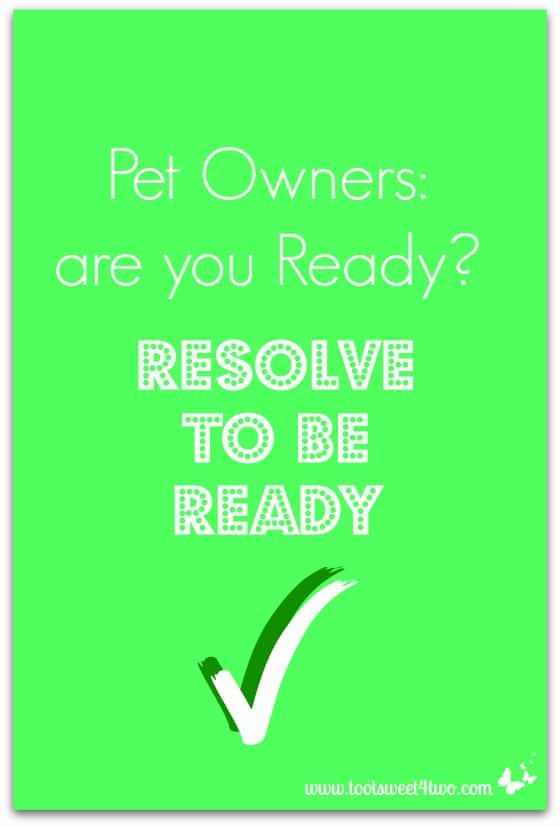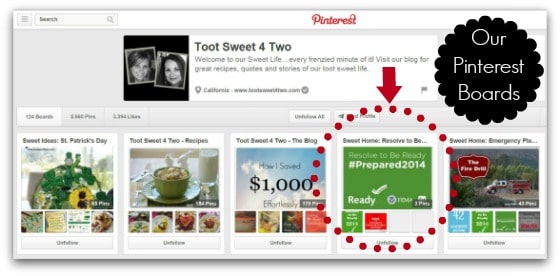Disclaimer: Please NOTE – we are Amazon affiliates. If you click on any Amazon link on our website and make a purchase, Amazon will pay us a small commission. This does not raise the cost of the product to you! If you do purchase products from Amazon by going through our site, we thank you! This helps to keep our content on this blog free to readers.

Regular readers of our blog will know we have a cat: A Boy Named Coco. Our somewhat antisocial cat brings us great joy (is that an oxymoron: antisocial cat = joy?) and is a much-loved and very spoiled pet. As all pet owners with a great love of animals know, losing Coco would absolutely crush us.
Because planning for your pet in the event of an emergency should be part of your family evacuation plan, this post (Pet Owners: are you Ready?), is the 3rd post in my new series on emergency planning and preparedness, focusing solely on the little fur babies that are an essential part of our lives.

If you missed the first two posts in this series, here’s a bit of background: we lost our home to wildfire in 2007. I have written a 20-part series about this and you can read it here: Any Way the Wind Blows.
Even though I’m probably more prepared for another disaster than most Americans, I’m continually surprised about how unprepared I am! So, on January 22nd of this year, I launched a new series on this blog, which coincides with FEMA’s Resolve to Be Ready 2014 campaign. On the 22nd of each month, I’m doing a post on emergency planning and preparedness, propelling me to be more prepared. My hope is that this series will also propel others to be more prepared. Here are links to the January 22nd and February 22nd posts:
- January – Resolve to Be Ready 2014
- February – Blackout: are you Ready?
Here’s what we did in January:
- Purchased a 3-ring binder and labeled it using this FREE printable: Family Emergency Planning and Resources Binder Cover PDF.
- Purchased a package of letter-sized sheet protectors with 3 holes to fit into the 3-ring binder.
- Printed out my Emergency Planning Checklist, read it and put in it the plastic sheet protectors and then inside the 3-ring binder.
- Printed out these two checklists from FEMA and put them in plastic sleeves and then into the 3-ring binder: Family Communication Plan for Parents and Family Communication Plan for Kids.
- Started a designated emergency fund by using my Saving Mr. Lincoln strategy. We will need money to buy things along the way.
- Started a Pinterest board called Resolve to Be Ready 2014 and pinned this post to the Pinterest board for future reference and to share with others.

This is what we did in February:
- Set a date and time to have a family meeting to discuss emergency planning.
- Chose an out-of-town contact and had a conversation with that person.
- Had the family meeting and completed the Family Communication Plan for Parents and the Family Communication Plan for Kids.
- In addition, completed the Commuter Emergency Plan for each commuter.
- Purchased a small plastic tub using some of the designated emergency funds. Placed the Family Emergency Planning and Resources Binder in the tub and placed the tub in a strategic location near one of our home’s exits.
- Purchased several flashlights with money from the designated emergency fund and placed them in several locations in our home, garage and one in the plastic tub.
- Selected a briefcase-size bag and designated that bag our “Fly-Away Kit”. Put copies of all completed forms in this fly-away kit. We’ve put the “Fly-Away Kit” under our bed, but you can designate a different location; just don’t put it with the small plastic tub.
- Had a family outing and drove to our emergency designated locations.
For more specific information about each of these steps, read Resolve to be Ready 2014 and Blackout: are you Ready.
So, this month’s challenge adds a plan for your pet. Why do you need a specific plan for your pet? Why isn’t your pet just considered part of the Family Emergency Plan? Because, of several factors:
- when an emergency occurs, you may not be home. What happens to your pets if you aren’t home?
- Suppose you are home and you have to evacuate your home. Did you know that most government-run and charitable shelters (such as most Red Cross run shelters) do not allow pets because of health and safety concerns? Usually the only exceptions are service animals. It is prudent to know the places in your area that are pet-friendly, including hotels/motels.

Coco on the back of a chair watching the swallows outside…crazy swallows arrived March 5th from Argentina! Read more about our swallows here, here, here, here and here.
Back to emergency planning…
So, between today and April 22nd, here’s what we can do to prepare as pet owners:
- Check out hotels and motels along your evacuation route and call them or do an internet search to determine pet-friendliness. Side note: in October 2007, during the Southern California wildfires and the evacuations that displaced 1,000,000, all local area hotels became “pet-friendly”. It was never questioned; they just did it. But, in smaller evacuations, hotels may not be so generous, so it makes sense to know your options. Make a list, including phone numbers, and put this list in both your Family Emergency Planning Binder and your “Fly-Away Kit.” Here’s a worksheet to use: Pet-friendly Hotels worksheet.
- Talk to your family, friends and neighbors about your pet(s). Ask more than one to be your “back-up” should an emergency occur when you are not home. Have them come over to your house and walk through what they will need to evacuate your pet safely. Show them where you keep collars, leashes, pet carriers, food, water and pet medications (if needed). Make sure to include a plan to be reunited with your pet within your immediate area and one farther away. Make a list of the people who’ve agreed to help you, including their phone numbers and place that information in both your Family Emergency Planning and Resources Binder and “Fly-Away Kit”. Be sure to include information about offsite repatriation with your pet. Here’s a worksheet to use: Pet Emergency Backup Plan worksheet.
- Talk to your veterinarian, local boarding facilities and animal shelters and ask them their policies in times of emergencies. It’s always nice to have “options” as respects your pets should your number one option (keeping your pet with you) may not be feasible. Also, make a list of these veterinarian and emergency services, including phone numbers, and place this information in both your Family Emergency Planning and Resources Binder and your “Fly-Away Kit”. Here’s a worksheet to use: Veterinarians, Animal Boarding Facilities and Shelters.
- If you have more than one pet, understand that you may have to house them separately in emergency situations. Be prepared for that possibility by having separate emergency supplies for each pet.
- Practice placing your pet in its pet carrier. Getting your pet used to the idea is easier if there is, indeed, an emergency.
- Make sure your pet’s vaccinations are up-to-date. Coco hasn’t been to the vet in at least 2 years. If Coco needs to go to a shelter (and believe me, that would be a last resort for us), without proof of updates, we may not be able to leave him. Place copies of these documents in both your Family Emergency Planning Binder and your “Fly-Away Kit”.
- If your pet wears a collar (Coco does not; we have tried and it just isn’t going to happen – nor is a harness!), make sure the collar has identifying information on it. If not, consider having your pet “micro-chipped” by your veterinarian.
- Have more than one leash and harness for each pet. For now, place an extra collar and leash in the small plastic tub with your flashlight and binder.
- Take a picture of you with your pet and print it out. Write details about your pet on this printed photo: name, species, breed, age, sex, color and distinguishing characteristics. Put this information in both your Family Emergency Planning Binder and your “Fly-Away” Kit. If you are separated from your pet, this photo may help in reuniting with your pet plus provide a form of proof of ownership of your pet.
- Using some of your emergency funds, purchase “Pets Inside” stickers and place them on your doors or windows, including information as to the number and types of pets in your home. This is to alert firefighters and rescue workers, in the event you are not home and your pets are. Several choices are available on Amazon.
Please NOTE: we are Amazon affiliates. If you click on any Amazon link on our website and make a purchase, Amazon will pay us a small commission. This does not raise the cost of the product to you! If you do purchase products from Amazon by going through our link, we thank you! This helps to make our content on this blog free to readers.
I have updated the Resolve to be Ready Project Checklist to include the items above. Click Resolve to Be Ready Project Checklist updated 3-22-2014 to print an updated one for your binder. Also, here are additional links to other sites with emergency information for pet owners:
- FEMA’s Resolve to be Ready Information for Pet Owners
- FEMA’s Resolve to be Ready Caring for Animals
- Be Red Cross Ready: Pets and Disaster Safety Checklist
Whew! Told you this wouldn’t be a “walk in the park” {grin}! This will be the last time that I repeat the previous months’ checklists within the post, because it’s just going to make the post too long {grin}! So, from now on, readers will need to refer to earlier posts about previous projects in this series. So, be sure to “pin” this post to your Pinterest board so that you can come back and reread this as often as needed. Until next time…
Tootles,

Related Posts:
(other posts about emergency planning and preparedness)
Leave a Reply